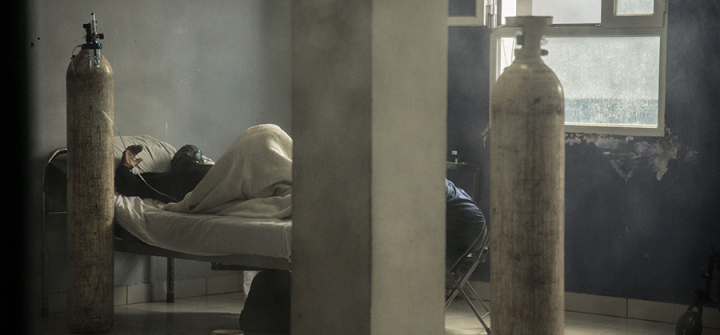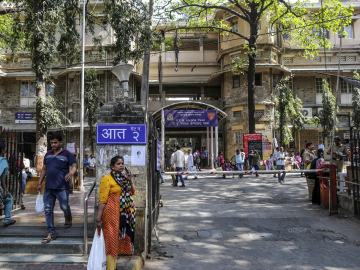Medical Oxygen: Key to Fighting COVID-19—and the Next Respiratory Pandemic
We take few things for granted the way we do oxygen. More than water, more than food, more than sunlight, we assume it will always be available. When it is not, we expect to quickly lose our breath, our focus, and perhaps our life.
But patients suffering from COVID-19 and pneumonia—as well as those giving birth and undergoing routine surgery—can experience oxygen deficiency without knowing it. When they are deprived of oxygen and doctors are unaware of the problem, treatable conditions get unnecessarily dangerous.
One of us, Peter Piot, recently came face-to-face with this reality. After spending more than 40 years fighting the viruses that haunt us around the world, Peter became infected with the virus that causes COVID-19. In a London hospital room, he recovered from pneumonia and severe oxygen deficiency, thanks to medical oxygen support.
A simple test revealed the emergency. Yet had he been in many other parts of the world, unable to access such a diagnosis and the medical oxygen to treat it, his story could have had a different ending.
Pneumonia, a serious illness caused by respiratory infections, can be deadly. Last year, it killed 2.5 million people worldwide, including 672,000 children. Because pneumonia is a common complication of COVID-19, an estimated 1.9 million additional deaths caused by pneumonia may occur this year—a 75% increase. The rise in pneumonia cases and potential deaths is especially alarming now, as COVID-19 cases spike worldwide.
Medical oxygen is often a critical intervention for both pneumonia and COVID-19. It is in fact one of the most essential medicines we have, a very effective treatment that is generally safe.
But as the WHO has noted, the global demand for safe, reliable access to medical oxygen has grown exponentially in low- and middle-income countries, and it remains elusive in places like Ethiopia, Uganda, Nigeria, and India.
Nine in 10 hospitals in low- and middle-income countries don’t have access to the working equipment that they need to diagnose and treat oxygen deficiency, like pulse oximeters and oxygen machines. Pulse oximeters, which often cost less than $50, track blood oxygen levels and can diagnose signs of oxygen deficiency, indicating when to provide treatment. When oxygen machines are available in these countries, studies have found that as many as 96% of the machines are broken. As a result, only 20% of patients who need oxygen receive it.
This oxygen access gap in low- and middle-income countries is one of the defining health equity issues of our age. It results in completely avoidable suffering: 33% of COVID-19 deaths and 75% of child pneumonia deaths occur in 33 low- and middle-income countries.
To address this crisis within a crisis, governments, in collaboration with NGOs and private corporations, must invest in access to medical oxygen and build sustainable systems to provide it to patients. An urgent investment in medical oxygen will serve two purposes: In the short term, it will fight the COVID-19 pandemic, and in the long term, it will save countless lives from pneumonia.
African countries, in particular, should invest in establishing national production systems for medical oxygen. Private-public partnerships can play a vital role in securing the investment and technical know-how in manufacturing and distributing oxygen systems. For example, in Kenya, a private corporation has positioned oxygen plants near health clinics and is using a delivery system to deliver oxygen to the clinics, making regular deliveries to pick up and refill empty oxygen cylinders. This system has helped overcome the hurdle of transporting oxygen cylinders between facilities and clinics.
Simultaneously, leaders must focus on providing the right resources, training, and guidelines to support health workers. For example, NGOs have worked for years in countries like Kenya and Nigeria to ensure health care providers have access to pulse oximeters. These existing efforts must be scaled up.
The challenge we face is not a mystery. It is a question of will and focus. While the world waits for a COVID-19 vaccine, people deserve access to the best treatment we have available now—no matter where they live. By investing in safe, reliable medical oxygen now, we can spare thousands of lives from premature death, weaken COVID’s deadly toll on our global society, and prepare countries for the next respiratory pandemic.
Peter Piot, MD, PhD, is director of the London School of Hygiene and Tropical Medicine. John Nkengasong, MSc, PhD, is director of the Africa Centres for Disease Control and Prevention.
Join the 50,000+ subscribers who rely on Global Health NOW summaries and exclusive articles for the latest public health news. Sign up for our free weekday enewsletter, and please share the link with friends and colleagues: https://www.globalhealthnow.org/subscribe
A COVID-19 patient on oxygen at the Andohatapenaka University Hospital in Antananarivo, Madagascar on July 20, 2020. Image: Rijasolo/AFP via Getty Images




